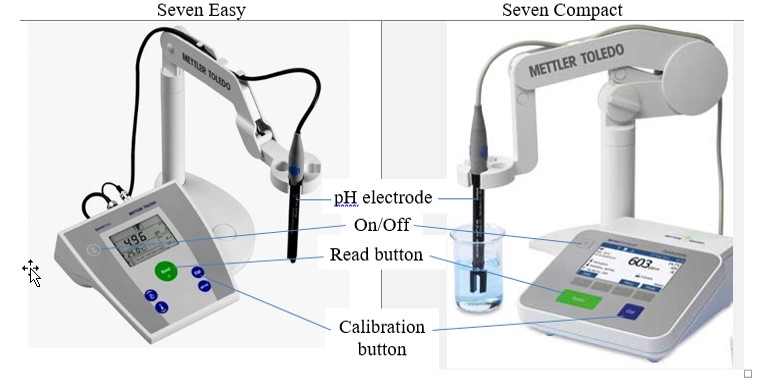You are viewing the public, limited version of the How-to Cards. Connect to the University network physically or via VPN to see all cards.
Card categories
Outline
Last modification
2024-11-23
pH meter: utilization and maintenance#
This How-to Card describes the routine maintenance of pH meter “Seven Easy” and “Seven Compact” from Mettler-Toledo.
Description#

Personal protective equipment#
Always wear a lab coat, safety glasses and gloves when working with the pH meter.

Maintenance#
- All calibration solutions should be kept away from the light.
- Any spillage has to be cleaned immediately. Use wipes to dry the spill, then clean with water.
- The electrode has to be constantly immersed in a 3 M KCl solution.
- Do not allow it to dry.
- Change the solution at least monthly.
- Indicate the date of change in the log book.
- If the filling solution is encrusted outside the electrode, remove it by rinsing the electrode with deionized water.
- Contact the quality officer if the logbook is full.
- If there is an issue with the instrument, create a ticket.
Calibration#
If you are the first user of the day, a calibration should be performed (write the date and the number of points in the logbook).
You can also perform a calibration if you have doubts about the calibration status of the instrument.
The pH meter allows for calibration of 1, 2 or 3 points.
The calibration standard solutions are of pH 4, 7 and 10.
- Rinse the electrode with MilliQ Type 1 water, wipe carefully the outside of the electrode with a lint free tissue.
- Place the electrode in a calibration standard and press “CAL”.
- The pH meter automatically endpoints when calibrating.
- For 2 points calibration, repeat steps 1 to 3 for the second calibration standard.
- For 3 points calibrations, repeat steps 1 to 3 with the third calibration standard.
- Rinse the electrode with MilliQ Type 1 water, wipe carefully the outside of the electrode with a lint free tissue.
- After calibration, to return to sample measurement, press on:
- “Read” for the Seven Easy;
- “End”, then “Save” for the Seven Compact.
- Add the calibration date in the equipment logbook.
How to prepare the calibration reagents#
- The calibration cannot be performed using the reagents directly in their original containers, they need to be aliquoted.
- Transfer a few millilitres of each of the three calibration solutions in a 15 mL falcon tube. Label them with the pH value of the solution and the date of aliquot.
- Indicate the opening date on the original bottles and store them in the dark.
- Keep the aliquoted solutions for a month, then replace them with fresh ones.
- Indicate the date of exchange of the solutions in the log book.
Measuring the pH#
- pH is temperature sensitive, therefore, make sure that your solution is at the temperature you will use it (for example: 37°C for cell culture medium).
- Make sure the sample has been thoroughly mixed.
- If you use magnetic stirrer, make sure you stop the stirrer before inserting the probe.
- Rinse the electrode with deionized water, wipe carefully the outside of the electrode with a lint free tissue.
- Place the electrode in the sample and press on “READ” to start the measurement.
- During measurement, the decimal point of the display flashes.
- Once the measurement is complete, the display freezes automatically.
- Rinse the electrode with deionized water and place it back in its storing solution container (a 15 mL falcon containing 5 mL of 3 M KCl for example).
- Adjust the pH of your solution, use a Pasteur glass pipet if you use strong acids or bases.